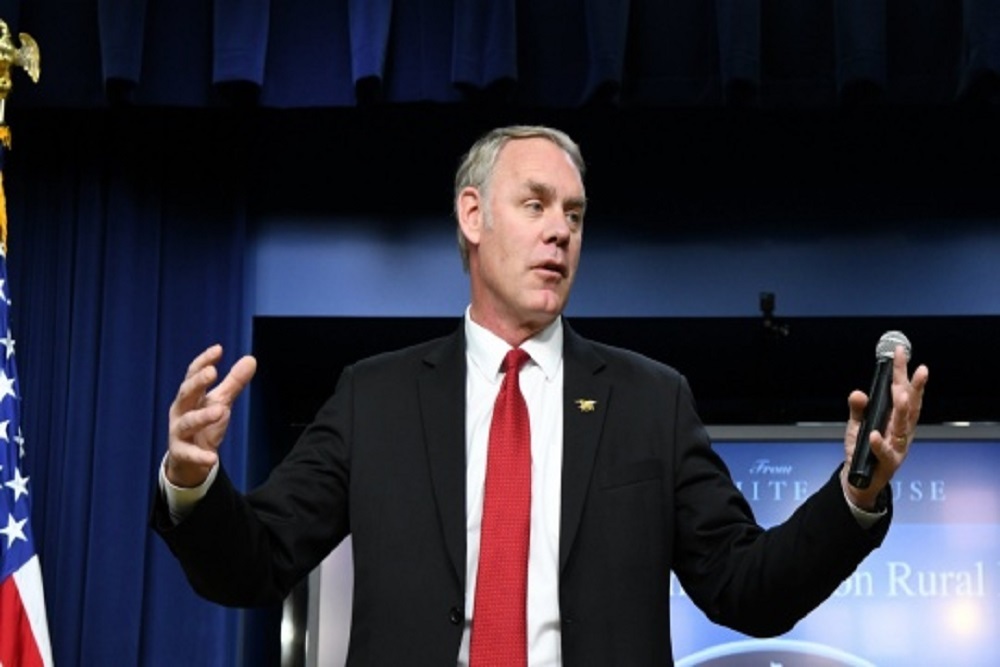U.S. Department of Interior issued the following announcement on April 9.
Today, U.S. Secretary of the Interior Ryan Zinke signed a Memorandum of Understanding (MOU) committing the Interior Department to follow President Trump’s One Federal Decision framework for processing of environmental reviews and permits for major infrastructure projects.
The MOU was also signed by Secretaries from the U.S. Department of Agriculture, U.S. Department of Commerce, U.S. Department of Housing and Urban Development, U.S. Department of Transportation, U.S. Department of Energy, U.S. Department of Homeland Security, U.S. Environmental Protection Agency, and the U.S. Department of the Army. Additional signatories to the MOU include the Chairman of the Federal Energy Regulatory Commission, Chairman of the Advisory Council on Historic Preservation, and the Acting Executive Director of the Federal Permitting Improvement Steering Council. These officials signed the MOU pursuant to a joint memorandum issued by Mick Mulvaney, Director of the Office of Management and Budget, and Mary Neumayr, the Acting Chair of the Council on Environmental Quality (CEQ).
“This agreement represents an unprecedented commitment by Federal agencies to work together to process environmental reviews for infrastructure projects,” said President Donald J. Trump. “Under this agreement, the Federal Government commits to being more customer service oriented in the time it takes to make decisions. Projects will continue to meet applicable environmental standards, but the process will now be done in a reasonable amount of time. I commend all of the Secretaries and agency officials for their leadership and hard work to implement my vision of One Federal Decision.”
“As both a lead agency and a permitting agency, the Department of the Interior understands the importance of having an efficient permitting process,” said Secretary Zinke. “I am 100 percent committed to ensuring that the Department does its part to collaborate and work together with other Federal agencies to complete the necessary reviews in accordance with the permitting timetable.”
President Trump has made it clear since day one that rebuilding America's infrastructure is a top priority. To ensure that the President's "One Federal Decision" process is successful, the Department of the Interior has implemented four distinct initiatives. These four initiatives include 1) A project permitting task force dedicated to streamlining the Department's permitting process across all bureaus; 2) Implementing policy guidance to ensure that our NEPA procedures comply with the portions of the CEQ regulations that require an Environmental Impact Statement (EIS) to be completed in 150 pages and on an expedient timeline; 3) Ensuring proper guidance, management, and attention to projects that fall within the parameters of FAST 41; and, 4) Interior is looking to reform the Endangered Species Act, and create regulations to better reflect the intent of the original legislation. Each one of these initiatives is being responsibly pursued to balance the Secretary's goals of environmental stewardship, conservation, and comprehensive land management.
Under the MOU, the co-signing agencies are committing to work together to make the necessary environmental and permitting decisions for major infrastructure projects, with a goal to complete the entire process within 2 years. In general, the MOU commits agencies to processing their reviews in accordance with the following 4 principles:
Establish a Lead Federal Agency for the Complete Process. Under the current process, project sponsors are responsible for navigating the decision-making processes of multiple Federal agencies. Under the MOU, Federal agencies agree to establish one Lead Federal Agency that will navigate the Federal environmental review and permitting process.
Commitment to Meeting the Lead Federal Agency’s Permitting Timetable. Under the current process, agencies are not generally required to follow a comprehensive permitting timetable. Under the MOU, Federal agencies agree to follow the permitting timetables established by the Lead Federal Agency with the goal of completing the process to 2 years.
Commitment to Conduct the Necessary Review Processes Concurrently. Under the current process, agencies may conduct their own environmental review and permitting processes sequentially resulting in unnecessary delay, redundant analysis, and revisiting of decisions. Under the MOU, Federal agencies agree to conducting their processes at the same time and relying on the analysis prepared by the Lead Federal Agency to the maximum extent possible.
Automatic Elevation of Interagency Disputes. Under the current process, interagency disputes sometimes linger for years in agency field offices before being elevated and resolved. Under the MOU, Federal agencies agree that interagency disputes will be automatically elevated and expeditiously resolved.
The Interior Department partners with other agencies across the Federal government to permit infrastructure projects. Currently, the Keystone XL pipeline project is going through the permitting process and the Department of the Interior is coordinating with the State Department and others to keep the decision-making process on schedule. Interior is also working on a MOU with the Department of Commerce (the National Oceanic and Atmospheric Administration & the National Marine Fisheries Service) to better coordinate on the offshore seismic permitting process, and the best possible way to navigate the technical differences on the issue between the agencies.
The President established the policy of One Federal Decision for the Federal Government’s processing of environmental reviews and permits for major infrastructure projects in Executive Order 13807. Under One Federal Decision, Executive Order 13807 requires that each major infrastructure project have a lead Federal agency that is responsible for navigating the project through the process, all Federal agencies to sign one “Record of Decision” (for purposes of complying with the National Environmental Policy Act), and relevant Federal agencies to issue the necessary permits for the project within 90 days of the signing of the Record of Decision. Executive Order 13807 established a 2-year goal for the completion of the environmental review and permitting processes for the signature of the Record of Decision and issuance of the necessary permits.
Original source can be found here.


 Alerts Sign-up
Alerts Sign-up